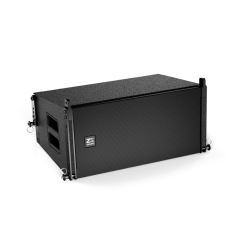To get the most out of powered line array speakers, there are several key factors that come into play to assure they sound their best and cover the room as well. Without the right set up and tune or a full understanding of room acoustics, these systems offer far less than just how advanced they are.
Correct line array placement and alignment is one of the keys to optimized performance. The height and angle of the array has to be calculated in accordance with venue's size & shape. For instance, in a 5,000-seater concert hall: hanging the line array at prerogative of due north (25-30ft) and letting it tilt slightly down arc helps uniform SPL coverage throughout. The curvature of the array also plays a key role in coverage control and helps to significantly reduce reflection from walls and ceilings. A well-aligned array sharpens directivity, reduces drop-outs in the sound and delivers consistent audio quality to near-field and far-field listeners.
Line array systemDeploy the acoustic ability to do tuning work Through a digital signal processor (DSP), the frequency response, delay & gain structure can be tuned to suit the acoustic attributes of venue. For example, in a place with great bass resonance you may apply x3-6dB cut from lower end to avoid any boominess or other side-effects of too boomy sound. Real-time analysis with tools such as Smaart or RTA (real time analyser) can help define the fine-tuning of precise positions to give us balanced, consistent sounds across all frequencies from our system.
A third important aspect in obtaining the very best from powered line array speakers is adequate power management. If you increase the volume during high-demand performances, make sure your amplifiers will deliver ample power without clipping to maintain audio quality. For example, if an amplifier is required to drive a line array module rated at 1000 watts continuous power then the amp should make between 1200 and (1500) watts per channel so that it can deliver peaks without distortion. This headroom is the margin that protects you from overloading and damaging your speakers / degrading sound quality. Moreover, employing power conditioners as well as voltage regulators provide the necessary protection to a system from electrical inconsistencies that also pose ill effects on performance.

One of the basic needs is knowing what the acoustic environment in a given place permits. Each venue has defining features that can determine audio transmission. Areas like this can create echoes and passthrough sound, making the sonorous result jitter. Therefore, the solution adopted in such cases is by deploying acoustic treatment like sound-absorbing panels or bass traps to take control of these effects thereby enhancing the clarity and intelligibility of audio. For outdoor events, where there aren't very many reflective surfaces and wind or temperature changes can have an effect on sound dispersion, the system has to be monitored carefully in real-time.
Powered line array speakers are not full range and must be paired with subwoofers for a complete sound delivery. To effectively match subwoofers wth the line array both crossover and phase alignment are conducted by those that know how to do such things… so placement is a way of life. For example, setting the crossover frequency at approximately 80-100 Hz for the subwoofers and main array can produce a natural handover between low end and mid-band frequencies. A cardioid or end-fire array of subwoofers can also be used to reduce low-frequency dispersion, which will decrease the amount of resonant voices drifting back and forth on stage while adding some full-energy delivery into the audience area.
Monitoring and maintaining the performance of the system during this critical moment is essential. This allows the sound engineers to make realtime adjustments directly from a central location in relation to levels, EQ's and delay keeping them consistent as more attendees arrive at the venue. In dynamic settings such as music festivals it is even more crucial due to rapid changes in crowd density and environmental conditions.
Other examples show how history emphasizes the necessity of these practices. In the case of the Glastonbury Festival, such setups are tuned in advance to deliver high-fidelity sound up onto vast open fields holding over 200,000 audience members. The system has been carefully aligned, tuned and powered alike so that everyone attending the festival is experiencing exactly the same levels of quality no matter where they are within it.
Simply put: maximizing the performance of a powered line array speaker system requires careful placement, meticulous tuning, intelligent power management and accommodation to environmental acoustics. In measuring these factors, sound engineers can make certain the system is providing clean and strong unified audio in any venue that will help ensure experiences are enriched for audiences.